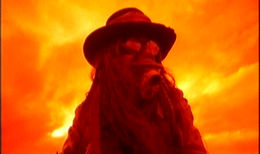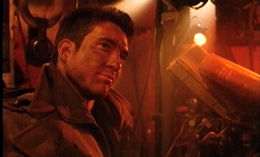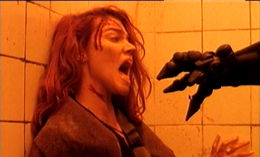
Color, 1990, 93m.
Directed by Richard Stanley
Starring Stacey Travis, Dylan McDermott, John Lynch, William Hootkins, Iggy Pop, Lemmy
Severin (DVD & Blu-Ray, US R0 NTSC/HD), Optimum (DVD & Blu-Ray, UK R2 PAL/HD) / WS (1.66:1) (16:9), Dragon (Germany R2 PAL)
 In a bleak futuristic desert wasteland, military zone patroller Mo (McDermott) acquires a sackful of mechanical pieces including a fascinating robot head. He decides to offer all of it back home to his sculptress girlfriend, Jill (Travis), upon his return along with his mystic, drug-taking cohort, Shades (Lynch). However, Mo and Jill's reunion lovemaking also triggers a switch in the robot, a military contraption named Mark 13, which assimilates the pieces from Jill's evolving sculpture around it to become a lean, extremely mean killing machine. Meanwhile Jill's activities are being monitored by a creepy, overweight voyeuristic neighbor (Hootkins), and as Mo begins to realize the full danger of the situation, Jill might be unable to leave her apartment as the technological menace begins its bloody rampage.
In a bleak futuristic desert wasteland, military zone patroller Mo (McDermott) acquires a sackful of mechanical pieces including a fascinating robot head. He decides to offer all of it back home to his sculptress girlfriend, Jill (Travis), upon his return along with his mystic, drug-taking cohort, Shades (Lynch). However, Mo and Jill's reunion lovemaking also triggers a switch in the robot, a military contraption named Mark 13, which assimilates the pieces from Jill's evolving sculpture around it to become a lean, extremely mean killing machine. Meanwhile Jill's activities are being monitored by a creepy, overweight voyeuristic neighbor (Hootkins), and as Mo begins to realize the full danger of the situation, Jill might be unable to leave her apartment as the technological menace begins its bloody rampage.
 Though it won't win points for originality, Hardware was never designed to break new narrative ground; even director Richard Stanley (who went on to direct the even more abused Dust Devil) admits the first version of the script was a derivative mess, and even now if you break the story down to its core elements, you've just got Dean Koontz's Demon Seed in cyberpunk dressing. What really makes the film is the style; love it or hate it, Hardware is a film you'll never forget. Each scene features strong, impressive imagery right from the haunting opening shot of a coated, masked scavenger trudging through the orange sand, and even the soundtrack pulses with a terrific Simon Boswell score and perfect song contributions from Public Image Ltd. and Ministry. Even Iggy Pop and Motorhead's Lemmy pop up, with the former scoring big only as a radio voice. The film also represents a delirious example of how much fun sci-fi could be when it wasn't afraid to splash the screen in blood; while the first half is deliberately paced and the very definition of a slow burner, the payoff is a riotous string of grisly death scenes and wild hallucinogenic sequences that fuse together in the striking finale.
Though it won't win points for originality, Hardware was never designed to break new narrative ground; even director Richard Stanley (who went on to direct the even more abused Dust Devil) admits the first version of the script was a derivative mess, and even now if you break the story down to its core elements, you've just got Dean Koontz's Demon Seed in cyberpunk dressing. What really makes the film is the style; love it or hate it, Hardware is a film you'll never forget. Each scene features strong, impressive imagery right from the haunting opening shot of a coated, masked scavenger trudging through the orange sand, and even the soundtrack pulses with a terrific Simon Boswell score and perfect song contributions from Public Image Ltd. and Ministry. Even Iggy Pop and Motorhead's Lemmy pop up, with the former scoring big only as a radio voice. The film also represents a delirious example of how much fun sci-fi could be when it wasn't afraid to splash the screen in blood; while the first half is deliberately paced and the very definition of a slow burner, the payoff is a riotous string of grisly death scenes and wild hallucinogenic sequences that fuse together in the striking finale.
Hardware inaugurated the 1990s on a particularly lurid note as it unspooled in theaters around the world in versions of varying degrees of explicitness. It caused quite a splash in the UK and among horror and sci-fi fans, but its wide release from Miramax in the US was plagued with controversy. First the film lost several shots (including arterial spraying in all the major death scenes) in order to avoid a dreaded X rating, and then the studio mounted a lavish but misleading campaign promising a film that would outdo Alien and The Terminator. Needless to say, many audiences were not amused when they found themselves watching a slow, gory, and sexually perverse art film. Nevertheless a steady cult following evolved, and fans had to scramble to see the uncut version either via a smudgy and barely letterboxed British VHS or a full frame, middling German DVD from Dragon.
 Fortunately the frustrating legalities and studio disinterest surrounding the film were eventually resolved, paving the way for a spectacular high-definition presentation that blows away the original theatrical experience. Much of the film was shot in low light with heavy red, orange and blue saturation, making it a nightmare for video technicians and even defeating many projectionists. The version available on DVD and particularly Blu-Ray is a revelation, yielding extremely impressive detail and finally showing exactly what's happening in those crimson-hued bedroom scenes. Both the British Optimum release and the American Severin edition are taken from the same HD master, though the former displays quite a bit more cinematic debris during the opening reels for some reason. The audio sounds fine on both, though the Severin sweetens the deal with both the original two-channel mix and a 5.1 option, while the Optimum only offers the former.
Fortunately the frustrating legalities and studio disinterest surrounding the film were eventually resolved, paving the way for a spectacular high-definition presentation that blows away the original theatrical experience. Much of the film was shot in low light with heavy red, orange and blue saturation, making it a nightmare for video technicians and even defeating many projectionists. The version available on DVD and particularly Blu-Ray is a revelation, yielding extremely impressive detail and finally showing exactly what's happening in those crimson-hued bedroom scenes. Both the British Optimum release and the American Severin edition are taken from the same HD master, though the former displays quite a bit more cinematic debris during the opening reels for some reason. The audio sounds fine on both, though the Severin sweetens the deal with both the original two-channel mix and a 5.1 option, while the Optimum only offers the former.
If the technical differences might seem to offer a clear choice between the two, the extras muddy the waters a bit. For the Severin,
Stanley contributes a terrific solo audio commentary; as he proved with Dust Devil, Stanley's one of the best raconteurs around and delivers a fast-paced if sometimes dark and cautionary chat track loaded with anecdotes about the film. Not surprisingly, his experiences in South Africa and various third world countries had a profound impact on the feature, and he also goes into the various visual and narrative influences which informed his first feature and reveals other odd bits of trivia, such as the casting of Sinead O'Connor in Lemmy's small role which fell through at the last minute. The Optimum version contains a somewhat different track (though with much of the same information) featuring Stanley and producer Paul Trybits, who also brings his own valuable perspective and often surprises Stanley with sometimes disturbing pieces of new information. Both are great, but either way you'll be happy to spend time hearing from Stanley about the making of the film.
The biggest extra from Severin (but completely missing from the Optimum) is "No Flesh Shall Be Spared: The Making of Hardware," a 53-minute retrospective with Stanley, Travis, Lemmy, Trybits, cinematographer Steven Chivers and prior Stanely cinematographer Greg Copeland, executive producer/Palace founder Stephen Woolley, producer JoAnne Sellar, and conceptual designer (and horror poster artist) Graham Humphreys. It's an excellent piece with everyone painting a thorough picture of the film's genesis; not surprisingly Stanley provides the essential framing device, and you'll hear all about the influences of Dario Argento and Mario Bava, the necessary rewrites when McDermott showed up for shooting far too buff to play the junkie loser Mo as depicted in the script, Travis' reaction to the request to dye her hair red, who came up with the Mark 13 Bible quote, and the convoluted rights and distribution issues which surrounded the film's release and dogged it for much of the video era.
Stanley's shorter work is well represented here on both releases. Sourced from VHS, the 44-minute "Incidents in an Expanding Universe" is a 1985 Super 8 effort about a futuristic bleak society with several elements later to appear in Hardware, including a lead male character with a robotic hand and lots of venetian blinds. The earlier "Rites of Passage" from 1982 is a moody 9-minute tale (scored with music from Cat People and The Shining!) about an immortal South African man dealing with the disillusionment of his condition, while the much more recent Stanley short, 2006's "The Sea of Perdition," is a gorgeous and completely inexplicable scope mood piece about a female astronaut on Mars who stumbles into a watery cave and... well, you'll see for yourself. Music from Paul Williams and Moonraker provides a strange accompaniment to this one, which purports to be part seven of a series "to be continued."
A hefty 25-minute offering of deleted and extended footage (sourced from a dropout-riddled VHS tape in Stanley's care) presents some interesting if disposable snippets, including an extended sex scene with some disturbing additional TV footage, a lot of additional chat between the leads, some funny outtakes from one of the key death scenes, and the original footage which eventually made its way into Mo's climactic flashback/hallucination scene. Also included is a 3-minute promo created to sell the film and the original German trailer; for some reason the overplayed Miramax US trailer is absent, but you can watch it online. Exclusive to the Severin (along with the aforementioned doc), Stanley also appears for a 7-minute video interview about the scuttled Hardware 2, whose script was conceived along with the first film; however, bickering ownership issues prevented it from ever reaching the big screen, and the concept actually sounds quite intriguing. The Optimum disc replaces the absent extras with the Stanley film Voice of the Moon which is also available on the Subversive release of Dust Devil. The Optimum disc makes up some of the ground with nifty limited edition packaging containing the controversial Shok! story which provided a partial (legally contentious) basis for the film, notes by Kim Newman, and collectible storybook art cards. However, for the value of the doc alone, the Severin release is easily the preferable option.



 In a bleak futuristic desert wasteland, military zone patroller Mo (McDermott) acquires a sackful of mechanical pieces including a fascinating robot head. He decides to offer all of it back home to his sculptress girlfriend, Jill (Travis), upon his return along with his mystic, drug-taking cohort, Shades (Lynch). However, Mo and Jill's reunion lovemaking also triggers a switch in the robot, a military contraption named Mark 13, which assimilates the pieces from Jill's evolving sculpture around it to become a lean, extremely mean killing machine. Meanwhile Jill's activities are being monitored by a creepy, overweight voyeuristic neighbor (Hootkins), and as Mo begins to realize the full danger of the situation, Jill might be unable to leave her apartment as the technological menace begins its bloody rampage.
In a bleak futuristic desert wasteland, military zone patroller Mo (McDermott) acquires a sackful of mechanical pieces including a fascinating robot head. He decides to offer all of it back home to his sculptress girlfriend, Jill (Travis), upon his return along with his mystic, drug-taking cohort, Shades (Lynch). However, Mo and Jill's reunion lovemaking also triggers a switch in the robot, a military contraption named Mark 13, which assimilates the pieces from Jill's evolving sculpture around it to become a lean, extremely mean killing machine. Meanwhile Jill's activities are being monitored by a creepy, overweight voyeuristic neighbor (Hootkins), and as Mo begins to realize the full danger of the situation, Jill might be unable to leave her apartment as the technological menace begins its bloody rampage.
 Though it won't win points for originality, Hardware was never designed to break new narrative ground; even director Richard Stanley (who went on to direct the even more abused Dust Devil) admits the first version of the script was a derivative mess, and even now if you break the story down to its core elements, you've just got Dean Koontz's Demon Seed in cyberpunk dressing. What really makes the film is the style; love it or hate it, Hardware is a film you'll never forget. Each scene features strong, impressive imagery right from the haunting opening shot of a coated, masked scavenger trudging through the orange sand, and even the soundtrack pulses with a terrific Simon Boswell score and perfect song contributions from Public Image Ltd. and Ministry. Even Iggy Pop and Motorhead's Lemmy pop up, with the former scoring big only as a radio voice. The film also represents a delirious example of how much fun sci-fi could be when it wasn't afraid to splash the screen in blood; while the first half is deliberately paced and the very definition of a slow burner, the payoff is a riotous string of grisly death scenes and wild hallucinogenic sequences that fuse together in the striking finale.
Though it won't win points for originality, Hardware was never designed to break new narrative ground; even director Richard Stanley (who went on to direct the even more abused Dust Devil) admits the first version of the script was a derivative mess, and even now if you break the story down to its core elements, you've just got Dean Koontz's Demon Seed in cyberpunk dressing. What really makes the film is the style; love it or hate it, Hardware is a film you'll never forget. Each scene features strong, impressive imagery right from the haunting opening shot of a coated, masked scavenger trudging through the orange sand, and even the soundtrack pulses with a terrific Simon Boswell score and perfect song contributions from Public Image Ltd. and Ministry. Even Iggy Pop and Motorhead's Lemmy pop up, with the former scoring big only as a radio voice. The film also represents a delirious example of how much fun sci-fi could be when it wasn't afraid to splash the screen in blood; while the first half is deliberately paced and the very definition of a slow burner, the payoff is a riotous string of grisly death scenes and wild hallucinogenic sequences that fuse together in the striking finale.
 Fortunately the frustrating legalities and studio disinterest surrounding the film were eventually resolved, paving the way for a spectacular high-definition presentation that blows away the original theatrical experience. Much of the film was shot in low light with heavy red, orange and blue saturation, making it a nightmare for video technicians and even defeating many projectionists. The version available on DVD and particularly Blu-Ray is a revelation, yielding extremely impressive detail and finally showing exactly what's happening in those crimson-hued bedroom scenes. Both the British Optimum release and the American Severin edition are taken from the same HD master, though the former displays quite a bit more cinematic debris during the opening reels for some reason. The audio sounds fine on both, though the Severin sweetens the deal with both the original two-channel mix and a 5.1 option, while the Optimum only offers the former.
Fortunately the frustrating legalities and studio disinterest surrounding the film were eventually resolved, paving the way for a spectacular high-definition presentation that blows away the original theatrical experience. Much of the film was shot in low light with heavy red, orange and blue saturation, making it a nightmare for video technicians and even defeating many projectionists. The version available on DVD and particularly Blu-Ray is a revelation, yielding extremely impressive detail and finally showing exactly what's happening in those crimson-hued bedroom scenes. Both the British Optimum release and the American Severin edition are taken from the same HD master, though the former displays quite a bit more cinematic debris during the opening reels for some reason. The audio sounds fine on both, though the Severin sweetens the deal with both the original two-channel mix and a 5.1 option, while the Optimum only offers the former.